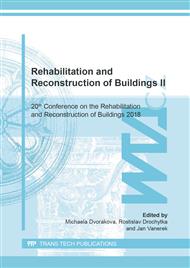[1]
L. Reinprecht, Ochrana dreva, Technická univerzita vo Zvolene, Zvolen, (2004).
Google Scholar
[2]
F. Simon, F. Marchal, F. Pochon, M. Kutnik, I. La Bayon, The potential of silicone-based formulations to enhance wood properties through industrial treatment for outdoor use, The International Research Group on Wood Protection, Stockholm, (2011).
Google Scholar
[3]
P. Gláser, V. Nejedlý, Organokřemičitany v české památkové praxi, NPÚ, Praha, (2008).
Google Scholar
[4]
J. Daňková, L. Reinprecht, T. Murínová, P. Mec, M. Pánek, L. Plevová, Performance of methyl-tripotassiumsilanol treated wood against swelling in water, decay fungi and moulds, Wood Research 58 (2013) 511–520.
Google Scholar
[5]
L. De Vetter, J. Van den Bulcke, J. Van Acker, Impact of organosilicon treatments on the wood-water relationship of solid wood, Holzforschung 64 (2010) 463–468.
DOI: 10.1515/hf.2010.069
Google Scholar
[6]
S. C. Gosh, C. Mai, H. Militz, The efficacy of commercial silicones against blue stain and mould fungi in wood, The International Research Group on Wood Protection, Stockholm, (2008).
DOI: 10.1007/s00107-008-0296-7
Google Scholar
[7]
J. Šesták, Měření termofyzikálních vlastností pevných látek: Teoretická termická analýza, Academia, Praha, (1982).
Google Scholar
[8]
V. S. Ramachandran, M. R. Paroli, J. J. Beaudoin, H. A. Delgado, Handbook of thermal analysis of construction materials, William Andrew, Norwich, (2002).
Google Scholar
[9]
J. Jae, G. A. Tompsett, Y. Ch. Lin, T. R. Carlson, J. Shen, T. Zhang, B. Yang, Ch. E. Wyman, W. C. Connera, G. W. Huber, Depolymerization of lignocellulosic biomass to fuel precursors: maximizing carbon efficiency by combining hydrolysis with pyrolysis, Energy and Environmental Science 3 (2010) 358–365.
DOI: 10.1039/b924621p
Google Scholar
[10]
M. Brebu, C. Vasile, Thermal degradation of lignin – a review, Cellulose chemistry and technology 44 (2010) 353–363.
Google Scholar
[11]
W. K. Tang, H. W. Eickner, Effect of Inorganic Salts on Pyrolysis of Wood, Cellulose, and Lignin Determined by Differential Thermal Analysis, Forest Products Laboratory, Madison, (1968).
Google Scholar
[12]
T. Majstríková, P. Mec, J. Daňková, Application of thermal analysis for the quantification of mineralization in surface wooden layers. Key Engineering Materials 776 (2018) 3–8.
DOI: 10.4028/www.scientific.net/kem.776.3
Google Scholar
[13]
Information on http://www.tainstruments.com/pdf/brochure/sdt.pdf.
Google Scholar


